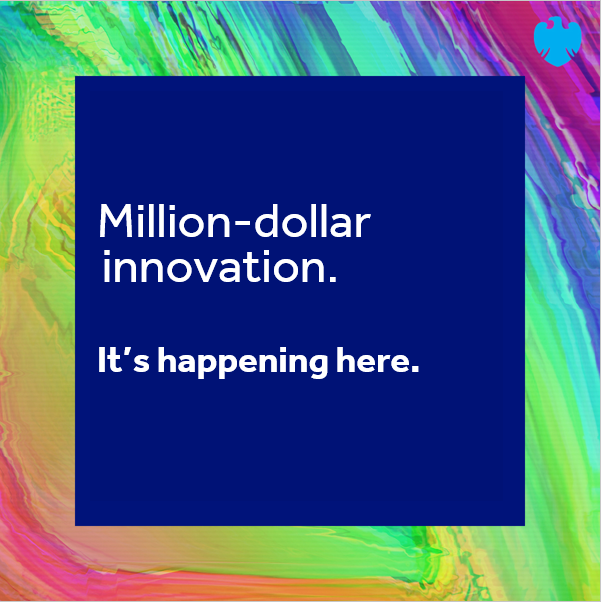
It’s not easy to choose the winners of Barclays’ Annual Group Technology Awards. From visionary DevOps thinkers to customer champions who created a mortgage advice hub in just three days, there are lots of amazing people, and incredible stories, across our global tech community. However, it’s fair to say that Bill Parrinello was a shoo-in for one of this year’s Change Champion awards.
As we migrated to a new voice recording platform, Bill saw an opportunity to upgrade the legacy systems we use for transcription, coming up with a strategic, in-house, speech-to-text voice surveillance solution from scratch. He taught himself the skills to deliver a proof-of-concept prototype, and then built a team to create and implement the new application, which outperforms our legacy solution. On top of that, he saved the business $1.5m by doing so.
Bill is a Technical Lead/Architect in Compliance Technology, with responsibility for the Speech-to-Text Voice Surveillance program. Like a lot of the award-winning minds across our tech organisation, he loves solving problems.
“That’s my job. People present me with a business problem, and I look at what technology can be applied to solve it,” says Bill.
Different architects approach the role in lots of different ways, but I am always hands-on. I like developing code and creating solutions. The bigger the challenge, the better. It’s more rewarding when you find the answer.
Monitoring thousands of hours of voice data created by traders every day has been an industry challenge for a long time. The secure and market-sensitive conversations that trading desks have are strictly regulated and, therefore, must be monitored for compliance purposes.
Originally, that process involved Compliance teams listening to a selection of calls every day. But, once the technology became viable, that evolved into automated voice surveillance - generating transcripts from voice data that could be checked through the firm’s electronic communications (eComms) surveillance platform. The transcription platform generates thousands of transcripts per day across multiple geographic regions. The eComms platform checks these transcripts for key compliance concerns and raises alerts to the Compliance team for review.
"Transcripts are never 100% accurate. There are so many factors, from background noise to the way people speak. But there’s a clear benefit to scanning every single conversation rather than just a selection. It allows our people to focus on listening to calls that are high risk", explained Bill.
When Bill first became involved with voice surveillance in 2018, the technology was far from perfect. The Compliance Technology team spent a lot of time with their transcription vendor, training the language models to understand the specialised business language of trading conversations. As Bill points out, that wasn’t the only issue.
Our legacy recording platform didn’t have a way of sharing high-quality audio with the transcription software. In order to get recordings of sufficient quality, our supplier created a bespoke solution, but the solution had limitations and was not scalable.
The first step towards change came with the recording platform itself. In collaboration with the firm’s global voice recording infrastructure team, the decision was made to upgrade to a new recording platform that could capture all different types of voice data, from standard desk phones and mobile devices to Teams calls and Trader Turrets (specialised telephony systems that sit on Trading desks). Furthermore, the new recording platform could be easily integrated with any transcription software.
The change of recording platform meant that we were no longer tied to our original transcription provider. So, Bill and his team started testing and evaluating new transcription engines in 2020. It had taken years, and considerable cost, to train our legacy transcription software to understand Barclays business language, but voice transcription was advancing rapidly and becoming more affordable. Bill explains, “the new transcription software selected is better than the old system right out of the box, being improved all the time and costs a fraction of the legacy software.”
By the end of 2021, Barclays had a new recording platform and a new transcription solution that could work in harmony across all our telephony systems, marking the start of our multi-year expansion journey. “It takes a long time to set up new platforms and roll-out new applications within highly regulated environments,” says Bill.
Deployment of the new recording platform was going well and happening at pace, but it would be another year or two before all devices, across the globe, were onboarded. Meanwhile, our $1.5m contract for the legacy transcription solution was up for renewal.
Bill saw an opportunity to design and implement an interim solution that would bring the surveillance program closer to its strategic goals, while saving the firm unnecessary spend.
Someone like me has to know how things work. So, I was always interested in how to generate audio files from the voice data on the network.
Bill went to his leadership team, Daylis Fuentes and Srini Sadasivam, and told them he could figure out an in-house solution. He explains, “with a big renewal bill coming up, it was at least worth trying. As usual, my leadership team was hugely supportive. I was given the month of February to come up with a proof of concept to present to the wider business. The renewal was due in September, so the clock was ticking.”
Bill researched the open-source technologies needed to design an innovative replacement and by the end of February he had a working proof of concept that was better than the legacy solution. “I was able to tweak my approach because I knew some of the things the legacy systems had struggled with in the past,” explains Bill.
Bill’s new solution, PUMA, was born! But now Bill needed to gain buy-in from several senior stakeholders, and put the solution into production fast.
Bill presented PUMA to senior tech colleagues for feedback and approval. He made a compelling case for the initiative, thoroughly covering technical design, resiliency, risk mitigation strategies and expected benefits. Next, Bill presented PUMA to Compliance stakeholders, helping them to clearly understand the limitations of the legacy tool and the tangible benefits they could achieve with PUMA.
With buy-in secured, Bill put together and led a small team to turn the proof of concept into something that could run automatically. “We wrote all new custom code for the solution, utilizing several open-source technologies to capture real-time voice data and generate audio files.”
After three months of active development and a fair amount of learning, Bill’s team put PUMA into user acceptance testing. By the end of July, PUMA went into production, running parallel to the legacy system.
Meanwhile, Bill kept PUMA’s various stakeholders informed of the solution’s progress. “There were actually two outages on the legacy system during PUMA’s development phase. So we were able to capture that missing data as we tested the system.”
On 20th September 2022, the legacy solution was switched off, and PUMA has been running on its own ever since. Bill’s interim solution didn’t just save the business $1.5m, it is more flexible and scalable than the legacy solution. It delivers a much better user experience, higher quality transcripts, and fewer false positive alerts for the Compliance team to review.
Bill recognized the need for change, saw the tangible benefits for Barclays, and took action. “I love solving problems that save a lot of money. I knew we could do better than what we had. It wasn’t going to be easy and there were elements of risk. But, with all of my experience and all the talent across Barclays’ tech teams, I had confidence that we could get it done. And I learned a ton of stuff along the way,” he says with pride.
I’ve been working with my manager for over 20 years and a lot of people on our team have been together for almost as long. We have faith in one another. The team knows that if I say I’m going to do something, I’ll get it done.
That sense of togetherness is at the heart of PUMA. Bill explains that “PUMA is short for Project Uma. We named the solution after a colleague; Uma Krishnan, who sadly passed away a few years ago. She was a good friend and a wonderful teammate. I always wanted to name something in her memory.”
So, what’s the next change for Bill to champion? “As the firm continues rolling out the new recording platform across different locations and devices, we will expand transcription coverage to many more users. Additionally, we’re investigating ways to expand our capabilities across a range of languages because a fair amount of the conversations recorded are in non-English languages.”
PUMA is a testimony to Bill’s initiative and innovative thinking. It’s a great example of Barclays’ Empower, Challenge, Drive mindset. It’s also proof of the trust and support that Barclays offers its people.


